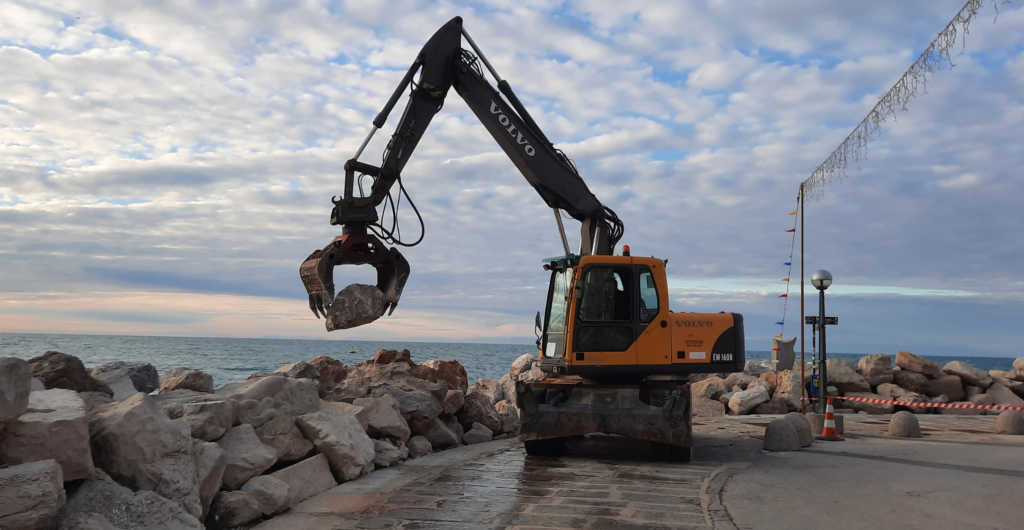Home » MedECC reports » Special Report on Climate and Environmental Coastal Risks in the Mediterranean » Summary for Policymakers [EN]
Special Report on Climate and Environmental Coastal Risks in the Mediterranean
Summary for Policymakers [EN]
Table of contents
Executive Summary
The coastal zone of the Mediterranean Sea is affected by multiple drivers of change: climate, pollution, biologic and socio-economic processes (Figure SPM1). This report describes their evolution, their impacts on ecosystems and people, the risks that are posed and solutions to reduce them, together with pathways for sustainable development. (Figure SPM2).
The Mediterranean coastal region is characterised by rapid, spatially diverse and geographically unbalanced socioeconomic development, mainly related to demographic trends, human settlement patterns and on-going wars and armed conflicts in different countries. The total coastal population of the Mediterranean is expected to grow faster than the inland population, thus leading to increased exposure of people and assets to coastal hazards. The northern Mediterranean may experience coastal population decline under some scenarios, while the highest increases in coastal population are expected in the Mediterranean Middle Eastern and Maghreb countries.
Climate change is affecting both the terrestrial and marine components of the Mediterranean coastal zone. Projections show an increase in surface air temperatures, frequency and intensity of hot extremes, sea level, evapotranspiration and decreased precipitation, depending on the level of future greenhouse gas emissions. Climate change is expected to pose serious risks for ecosystems and important economic sectors such as summer beach tourism, agriculture, aquaculture and fisheries.
The Mediterranean coastlines have experienced an accelerating relative sea level rise, which is expected to continue during the coming decades and centuries. Rising sea levels will exacerbate the risks of coastal floods, permanent inundation of some areas, and coastal erosion, with consequences for ecosystems and efficiency of present defences. Coastal structures, such as airports, transport networks, ports, and cultural heritage sites will be at risk. Both protection against coastal flooding and management of coastal erosion generally do not adequately consider future sea level rise, with risks of limited future efficiency. Climate change and growing urbanisation will further increase the risk posed by flash floods in some coastal areas.
Risks of water scarcity in the coastal areas of the Mediterranean are caused by the overall drying trend affecting the region, salinisation of coastal aquifers, increasing demand associated with population growth, irrigation, tourist use, industry and the energy sector. Risks of water scarcity are expected to increase in the future. Adaptation to decreasing water availability is taking place in Mediterranean coastal areas, with needs that vary significantly across sub-regions, depending on the population dynamics, the hydrogeological context and water management practices. These adaptation options consist in increasing water supply, improving water quality, supporting measures and governance, and to a lesser extent, reducing water demand.
In the Mediterranean Sea, observed mass mortalities in coastal waters have been partially attributed to marine heat waves and are expected to increase in the future. Mediterranean coastal wetlands have significantly declined since the beginning of the 20th century and further reduction is expected in the future. The efficiency of the conservation measures in coastal ecosystems strongly depends on the success of climate change mitigation and an increasing number of hard limits will be reached for every increment of global warming. The Mediterranean is also becoming increasingly colonised by non-indigenous tropical species and changes in the distribution and population of species have been observed. However, solutions have been rarely attempted.
Mediterranean coastal areas are polluted by micro- and macro-plastics, metals, persistent organic pollutants and emerging pollutants, with nutrient inputs from land, producing eutrophication in several coastal areas with negative impacts on ecological systems, human health and economic sectors (aquaculture, fishing, and coastal tourism). Pollution originates from numerous human activities, which are mainly land-based, such as industry, agriculture, urbanisation, and tourism. Future pollution levels along the Mediterranean coasts are expected to exhibit varying trends across regions and pollutants, depending on regulations, dependency, production, treatment, and socioeconomic changes. Pollution control at its source is generally more efficient than treating it at the endpoints. Actions to tackle pollution at a Mediterranean basin-scale have not been implemented yet, and both technical and decision-making challenges remain.
The engagement of scientists with policymakers, stakeholders, and citizens is a key factor to removing barriers (including lack of understanding and trust) and can be particularly beneficial during the planning process. Turning stakeholders into partners significantly increases the potential of successfully implementing solutions and adaptation measures.
In the Mediterranean coastal zone, present actions towards solutions to environmental problems, adaptation to climate change and its mitigation are insufficient to attain the UN Sustainable Development Goals (SDGs) ensuring the well-being of people and the sustainability of resources. Without transformative actions across all sectors, systems, and scales, climate change risks will be exacerbated, and the sustainable development goals will not be met. Social-economic and gender-based inequalities, lack of access to basic services will act as further barriers to the implementation of sustainable development pathways.
Adopting actions consistent with sustainable development pathways requires the proper identification of vulnerabilities related to human activities and climate change impacts, and assessment of options to reduce risks to the affected communities and ecosystems. A mix of legal, policy and economic instruments, and behavioural nudges are available at local, national, and regional level to promote effective and resilient development pathways in the Mediterranean coastal zone.
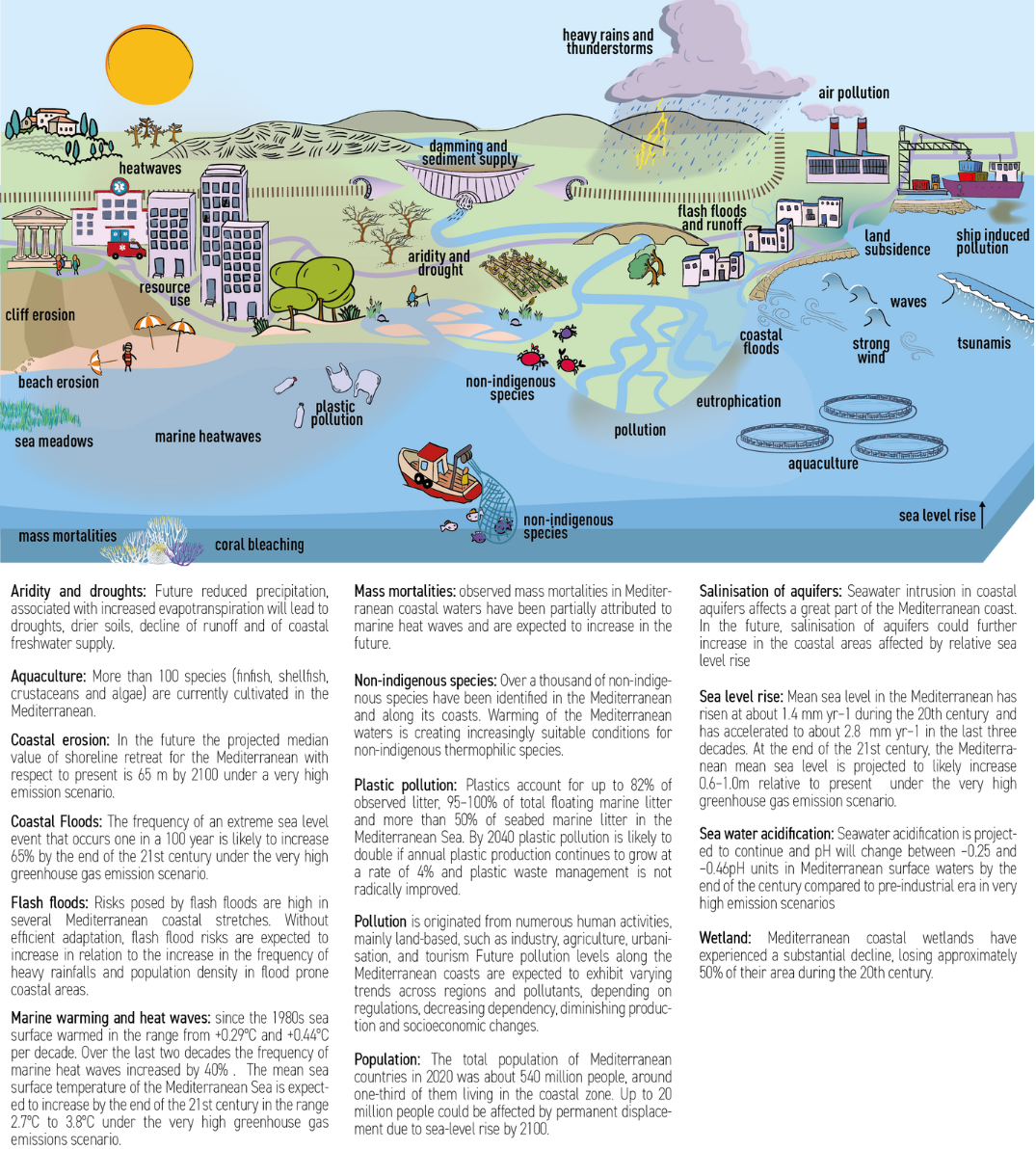
Figure SPM1 | The coastal zone and drivers of environmental and climate change
A. Framing: scope and basic concepts
A.1 This Special Report identifies and assesses environmental and climate change hazards in the coastal zone of the Mediterranean Basin, the related risks, adaptation options and solutions. It further assesses and provides information on actions to meet the United Nations Sustainable Development Goals (SDGs), such as combating climate change, increasing food security, ensuring water resources, accessing affordable and sustainable energy resources, managing natural resources, creating opportunities for social inclusion, and economic prosperity. Adaptation plans are presented by placing the social and cultural values in context of the region and its local traditions, considering the need to protect communities and biodiversity, minimise impacts on the natural environment, and addressing ethical considerations important for socially-oriented adaptation policies. (Figures SPM1, SPM2)
A.1.1 Policies to manage coastal risks and adaptation strategies in the Mediterranean coastal zone are important to the whole region, as a third of the Mediterranean population lives close to the sea and depends on infrastructure and economic activities in its immediate vicinity.
A.1.2 The coastal zone can be defined using objective and subjective criteria, often with a high level of uncertainty or fuzziness. Depending on the technical, economic or legal implications, the definition and extent of the coastal zone may vary significantly in the literature. This report does not aim to propose a general definition, instead it adopts a loose criterion that the coastal zone consists of areas geographically connected to the coastline, including land areas directly impacted by marine processes and sea areas directly impacted by terrestrial processes.
A.1.3 The Mediterranean coastal zone is often narrow and over-pressured and requires a specific risk assessment tailored to its characteristics to inform adaptation pathways and support decisions towards risk reduction and sustainability in coastal governance, policies and social perception.
A.2 This Special Report, as with other MedECC assessments, and international and national assessment processes, is based on the available, relevant and traceable evidence in the published scientific literature, including different lines of evidence (observational products, model-based findings and other types of data and analyses).
A.2.1 This report applies the calibrated terms that were adopted transversally by the Intergovernmental Panel on Climate Change (IPCC) since the 5th Assessment Report in order to communicate the robustness and certainty of assessment findings either qualitatively or quantitatively. The calibrated terms quantify confidence and likelihood. The terms are attributed to the assessment outcome by the author team following an evaluation of the available evidence. The designation of confidence and likelihood are agreed upon through a consensus-building discussion of the evidence, reflecting all expert views that are expressed. The scientific evidence for each key finding is found in the chapters of the underlying report and referred to in curly brackets {}. Each finding is grounded in an evaluation of underlying evidence and agreement. A level of confidence is expressed using five qualifiers: very low, low, medium, high and very high, and typeset in italics, for example, medium confidence. The following terms have been used to indicate the assessed likelihood of an outcome or result: virtually certain 99–100% probability; very likely 90–100%; likely 66–100%; about as likely as not 33–66%; unlikely 0–33%; very unlikely 0–10%; and exceptionally unlikely 0–1%. Additional terms (extremely likely 95–100%; more likely than not >50–100%; and extremely unlikely 0–5%) are also used when appropriate. Assessed likelihood is typeset in italics, for example, very likely.
A.2.2 A common set of key dimensions is used in this report on the basis of information that is available in the scientific literature, including well-defined time frames, baselines for past changes and conditions, a subset of representative scenarios of future changes, and well-known frameworks, such as the Sustainable Development Goals (SDGs).
A.2.3 Shared Socioeconomic Pathways (SSP) are cited as defined in IPCC AR6 based on future greenhouse gases (GHG) emissions, labelled after the SSP narrative and associated radiative forcing values in the year 2100 (1.9, 2.6, 4.5, 7.0, and 8.5 W m–2). SSP1-1.9 - very low GHG emissions and SSP1-2.6 – low GHG emissions (CO2 emissions reduce to net zero in the 2050s), SSP2-4.5 – intermediate GHG emissions (CO2 emissions remain around current levels until 2050, then falling but not reaching net zero by 2100), SSP3-7.0 – high GHG emissions and SSP5-8.5 – very high GHG emissions (CO2 emissions roughly double from current levels by 2100 and 2050, respectively).
A.2.4 Representative Concentration Pathways (RCP) defined in IPCC AR5 are cited. RCPs are greenhouse gas concentration (not emissions) trajectories labelled by the associated radiative forcing values in the year 2100 (2.6, 4.5, 6, and 8.5 W m–2, respectively and corresponding to one stringent mitigation scenario (RCP2.6), two intermediate scenarios (RCP4.5 and RCP6.0) and one scenario with very high GHG emissions (RCP8.5).
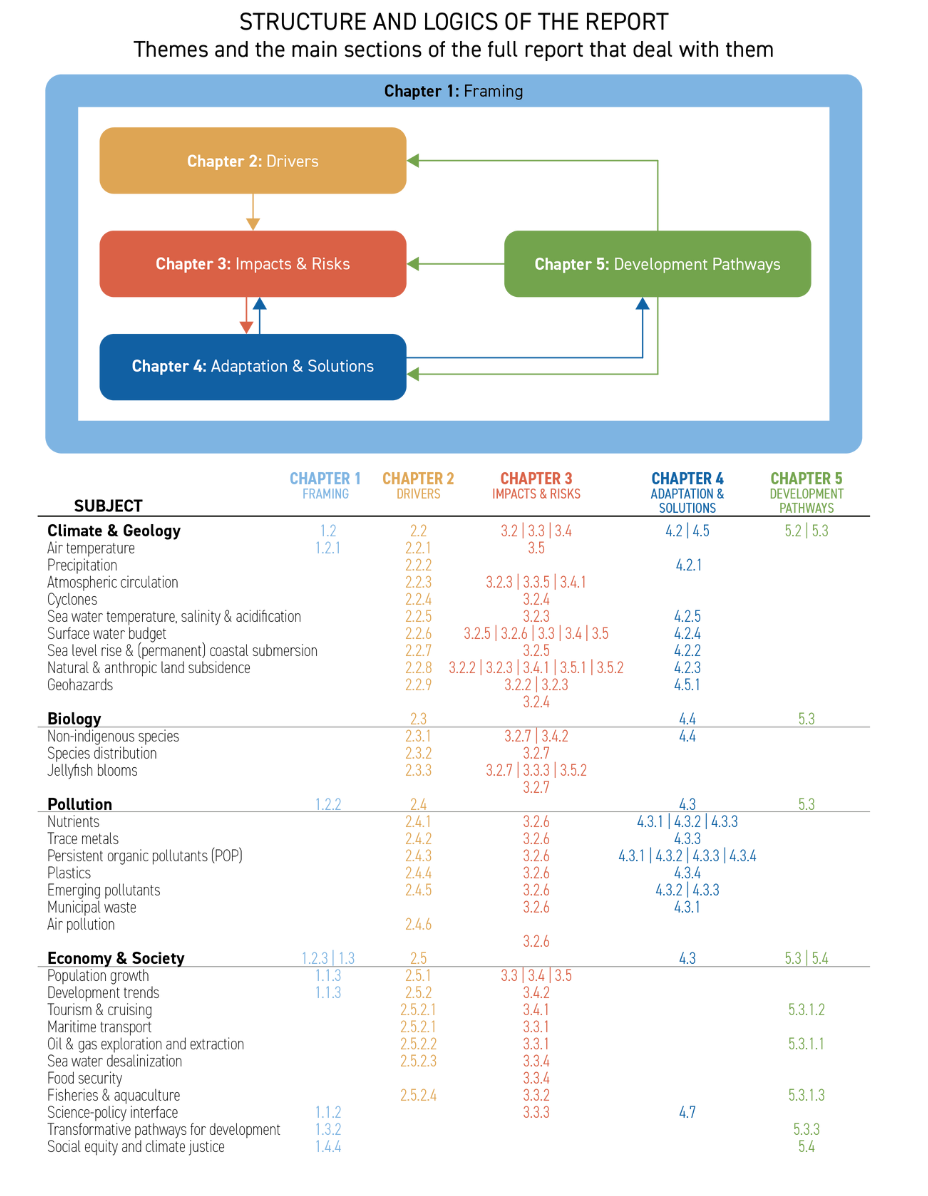
Figure SPM2 | Visual guideline to the content of the report. Structure and logics of the report showing references to the sections of the full report in which the listed issues are addressed
B. Present status of the climate and environmental drivers for the coastal area
B.1 Climate change is affecting the whole Mediterranean environment, including the terrestrial and marine components of its coastal zones. (Figure SPM3) {2.2}
B.1.1 Overall, the increasing trend of the period 1970–2019 implies that the 30-year average surface air temperatures of the Mediterranean region in 2020 was 1.5°C warmer than the pre-industrial period 1860–1890, with an increasing trend of the order of 0.01– 0.05°C yr–1 since the 1980s (high confidence). {2.2.1}
B.1.2 The change in Mediterranean Sea surface temperatures has been characterised by multidecadal variations superimposed by a long-term positive trend since the preindustrial period with an increase of about 0.86°C in 100 years (high confidence). Satellite data since the 1980s show spatially different warming rates of the sea surface between +0.29°C and +0.44°C per decade, and higher in the eastern Mediterranean. Over the last two decades the frequency and duration of marine heat waves increased by 40% and 15%, respectively (high confidence). {2.2.1, 2.2.5}
B.1.3 The magnitude and pattern of the observed precipitation trends over the Mediterranean exhibit pronounced spatial variability and depend on the time period and season considered (high confidence). {2.2.2}
B.1.4 The estimated decrease in the pH of Mediterranean Sea surface waters is between 0.055 and 0.156 pH units since the preindustrial period (high confidence). {2.2.5}
B.2 Mediterranean coastlines have experienced relative sea level rise, which is the sum of mean sea level rise and vertical land motion, with an accelerated rate during the last three decades (1993–2A018). {2.2.7, 2.2.8}
B.2.1 Mean sea level in the Mediterranean shows an approximate trend of ~1.4 mm yr–1 during the 20th century (high confidence), and has accelerated to 2.8 ± 0.1 mm yr–1 in the last three decades (1993–2018) (high confidence). The interannual and decadal variability that is superimposed to this trend can temporarily mask it. {2.2.7}
B.2.2 Vertical land motion along the Mediterranean coasts generally ranges from 0 to –10 mm yr–1, with isolated positive values. This widespread subsidence is mainly determined by geological factors such as tectonic subsidence and natural sediment compaction but is increased by human activities such as the withdrawal of underground fluids (water, oil and gas, drainage of organic soils) that contribute significantly to relative sea level rise in some areas [*] (high confidence). {2.2.8}
*In the coastal region of the eastern Nile Delta in Egypt, Thessaloniki in Greece, the city of Venice, the Po Delta, the Arno River and the coastal plain of Catania in Italy, the Ebro delta in Spain, and the Medjerda Delta in Tunisia.
B.2.3 Coastal flooding in the Mediterranean due to storm surges and wind waves threatens the flood-prone areas in the waterfronts (river mouths and deltas) and low-lying coastal plains in many Mediterranean countries. Relative sea level rise has already increased the frequency of floods of the Venice city centre, Italy (high confidence). {2.2.4}
B.3 Mediterranean coastal areas are polluted by micro- and macro-plastics, metals, persistent organic pollutants and emerging pollutants from various sources, with nutrient inputs from land causing eutrophication in several coastal areas. (Figure SPM3) {2.4}
B.3.1 Coastal water pollution originates mainly from land-based sources, followed by air and ship-originated sources. Pollution sources include domestic effluents, agricultural runoff, road transport, maritime transport, mine tailings, manufacturing and extractive industries. {2.4}
B.3.2 The Mediterranean Sea is one of the most heavily plastic polluted areas across the globe and floating plastics accumulate along its coasts as a result of human activities and marine circulation (high confidence). Plastics account for up to 82% of observed litter, 95–100% of total floating marine litter and more than 50% of seabed marine litter in the Mediterranean Sea. About two thirds of all the plastic debris from land-based sources (rivers, urban and industrial areas, and intensive agricultural areas) is retained along the coasts, where its level has remained steady for the past two decades, with several hotspots of plastic fluxes* (medium confidence). {2.4.4}
*The coastlines of Algiers in Algeria, Israel, Marche and the Po Delta in Italy, Barcelona in Spain, Bizerte in Tunisia, Mersin in Türkiye, and Syria
B.3.3 Human activities have led to increased concentrations of potentially toxic metals with hotspots of lead, mercury and cadmium located on the northern, central and south-eastern shores of the Mediterranean Basin (high confidence). Manufacturing of refined petroleum products (southern Mediterranean, Balkans and Türkiye), tanning and dressing of leather, and manufacturing of cement (Balkans and Türkiye) and energy production (Mediterranean EU countries) contribute to the release of heavy metals in coastal waters impacting marine ecosystems. Mercury concentrations exceed European Union regulatory thresholds in many Mediterranean top-predatory fish. Methylated mercury concentrations in western Mediterranean waters are twice as high as in the eastern Mediterranean (high confidence) and are biomagnified in marine food webs (medium confidence). In general, the release of toxic metals is decreasing for the European Union countries, but opposite trends are reported in some areas (high confidence). {2.4.2}
B.3.4 Pollution sources such as domestic effluents, runoff from agricultural practices and urban runoff introduce emerging pollutants and persistent organic pollutants into the coastal zone, with higher concentrations in the northern than the southern shores. Pollution from polycyclic aromatic hydrocarbons (PAHs) and polychlorinated biphenyls (PCBs) has been detected along some stretches of the Mediterranean coastline with the highest levels observed around river mouths, and harbour and industrial areas (medium confidence). Shipping is one of the main sources of oil pollution in Mediterranean coastal areas, with about 90% of tanker spills occurring near the coastlines and particularly affecting the eastern coasts (medium confidence). {2.4.3}
B.3.5 Nutrient flows of nitrogen and phosphate have decreased in most of the northern Mediterranean over the last two decades, following the implementation of best agricultural management practices and technological advances in wastewater treatment plants. However, nutrient pollution has increased in the southern and eastern Mediterranean in parallel with agricultural intensification and urban and industrial development (high confidence). {2.4.1}
B.4 Biological drivers in the Mediterranean and along its coast include the presence of over a thousand non-indigenous species, making it a major invasion hotspot, and jellyfish blooms. (Figure SPM3) {2.3.2, 2.3.4}
B.4.1 Non-indigenous species are accidentally introduced into Mediterranean coastal waters, estuaries or coastal lagoons, by aquaculture facilities, aquarium species trade, boat ballast waters and biofouling on vessels. Most non-indigenous subtropical coastal fish species enter the Mediterranean from the Red Sea. Warming of the Mediterranean waters is creating increasingly suitable conditions for non-indigenous thermophilic species, which are expanding their distribution ranges (high confidence). {2.3.2, 2.3.3}
B.4.2 The frequency of jellyfish blooms has increased in the Mediterranean Sea with some evidence that they benefit from eutrophication, warming of sea water and other human induced stressors (medium confidence). {2.3.4}
B.5 The Mediterranean coastal region is characterised by rapid, spatially diverse and geographically unbalanced socioeconomic development, mainly related to demographic trends, human settlement patterns and on-going wars and armed conflicts in different countries. (Figure SPM3)
B.5.1 The total population of Mediterranean countries in 2020 was about 540 million people, around one-third of them living in coastal areas, with a high concentration of urban settlements near the coast. {2.5.1}
B.5.2 The development gap between the northern, southern and eastern countries in terms of economic growth, income, population growth and education continues to persist and is further exacerbated by war and social unrest in several eastern and southern Mediterranean countries (high confidence), potentially reducing the adaptive capacity to coastal hazards (medium confidence). {2.5.2}
B.5.3 The Mediterranean is the world’s leading tourism destination, both internationally (it attracts about one third of the world's tourism) and domestically, with over half of the EU’s tourist accommodation establishments located in coastal areas. While the northern countries are mature/traditional tourism destinations, some southern countries, such as Egypt and Türkiye, have recently experienced a significant growth in coastal tourism. {2.5.2, 5.3.1}
B.5.4 The Mediterranean drainage basin incorporates more than 160 rivers, most of which are small and distributed across the European side of the Mediterranean coast. About 46% of the total length of the Mediterranean coastline has been formed by sediment deposition whose supplies have been significantly reduced by damming of Mediterranean rivers (medium confidence) {2.5.2}
B.5.6 The majority of fish stocks are overexploited (high confidence) which also poses serious economic problems. The most overexploited priority species in the Mediterranean is the European hake, which, due to its presence in most trawl fisheries, shows an average overexploitation rate 5.8 times higher than the sustainability target. {2.5.2}
B.5.7 The Mediterranean has experienced an upward trend in aquaculture production driven primarily by increased production in Egypt and Türkiye, followed by Greece, Italy, Spain, France, and Tunisia. More than 100 species (finfish, shellfish, crustaceans, and algae) are currently cultivated within a wide range of environments and farming systems. {2.5.2}
C. Future evolution of climate and environmental drivers for the coastal area
C.1 Surface air temperatures in the Mediterranean region are projected to very likely continue to increase more than the global average, together with an increase in frequency and intensity of hot extremes, increase of evapotranspiration (high confidence), decrease in precipitation (high confidence for 4°C global warming level) depending on future reductions in greenhouse gas emissions. (Figure SPM3)
C.1.1 Surface air temperatures in the Mediterranean region, relative to 1850–1900, are projected to increase by 2.1 [1.6 to 2.7] °C over the period 2041–2060 and 2.2 [1.6 to 3] °C over the period 2081–2100 under the very low GHG emissions scenario , and by 2.2 [2.3 to 3.6] °C over 2041–2060, and 5.5 [4.2 to 6.8] °C over 2081–2100 under the very high GHG emissions scenario (high confidence). Heat waves will increase both over land and sea (high confidence). {2.2.1}. (In the report, unless stated otherwise, square brackets [x to y] are used to provide the assessed very likely range, or 90% interval).
C.1.2 Precipitation will decrease over most of the Mediterranean and heavy rainfall will increase in some areas of the northern Mediterranean (low confidence for 1.5°C global warming level, high confidence for 4°C global warming level). Global warming will further increase the existing difference in intensity of precipitation and hydrological extremes between the northern and southern Mediterranean (high confidence). The projected increase in dry spell length is larger in the southern Mediterranean than in the northern Mediterranean (medium confidence). {2.2.2}
C.1.3 Future decreases in precipitation, associated with increased evapotranspiration will lead to droughts, with drier soils and a decline in runoff and coastal freshwater supply, to become more severe under moderate emission scenarios and strongly enhanced under severe emission scenarios (high confidence). {2.2.6}
C.1.4 Compared to the end of the 20th century (1976–2005), the sea surface temperatures of the Mediterranean Sea are projected to increase by the mid-21st (2021–2050) century in the range of 0.6°C to 1.3°C and by the end of the 21st century (2071–2100) in the range of 2.7°C to 3.8°C under the very high GHG emissions scenario (high confidence). The warming at the end of the century will be smaller (from 1.1°C to 2.1°C) under an intermediate scenario. Warming is expected to be stronger in summer than in winter (medium confidence) and associated with longer and more intense marine heat waves (high confidence). {2.2.5}
C.1.5 Seawater acidification is projected to continue both off-shore and at the coast (virtually certain). It is projected that the pH will decrease between –0.25 and –0.46 units in Mediterranean surface waters by the end of the century compared to the pre-industrial era in very high GHG emissions scenarios (medium confidence). {2.2.5}
C.1.6 The future change in sea surface salinity of the Mediterranean Sea remains largely uncertain with very low confidence on its sign of change. Any change will likely be spatially and temporally inhomogeneous due to the primary role of river and near-Atlantic freshwater inputs (medium confidence). {2.2.5}
C.2 Mediterranean relative mean sea level is expected to continue to rise during the coming decades and centuries at a rate depending on the future emissions of greenhouse gases (virtually certain). The increase in relative sea level will cause more frequent coastal floods covering larger coastal areas (virtually certain). (Figure SPM3) {2.2.4, 2.2.7}
C.2.1 Mediterranean mean sea level is projected to rise during the coming decades and centuries, likely reaching 0.15–0.33 m by mid-21st century, and 0.32–0.62 m under the very low greenhouse gas emissions scenario and 0.63–1.01 m under the very high greenhouse gas emissions scenario by the end of 21st century, relative to 1995–2014 (medium confidence). The process is irreversible at the scale of centuries to millennia (high confidence). The long-term knowledge of vertical land movements is restricted to a limited number of sites where geological or geodetic surveys have been carried out. {2.2.7}
C.2.2 The frequency of an extreme sea level event that occurs once in 100 years is likely to increase by 10–30% and 22–65% by the mid and end of the 21st century under an intermediate and very high emissions scenario respectively (high confidence). {2.2.4}
C.3 Future pollution levels along Mediterranean coasts are expected to exhibit varying trends across regions and pollutants, depending on regulations, decreasing dependency, diminishing production and socioeconomic changes. The leakage of plastics into the sea will depend on the rate of plastic production, regulations and waste management (high confidence). (Figure SPM3) {2.4}
C.3.1 Nutrient fluxes in the coastal zone are expected to decrease in the north due to the implementation of European environmental regulations and to increase in the south if urban development and agricultural intensification continue at the present pace (high confidence). The current nutrient imbalance in coastal ecosystems, with increasing availability of nitrogen relative to phosphates, leading to exacerbated eutrophication problems, is expected to increase (high confidence). {2.4.1}
C.3.2 Concentrations of certain persistent organic pollutants (POPs), such as polychlorinated biphenyl (PCBs) and dichlorodiphenyltrichloroethane (DDT), will continue to decline in Mediterranean coastal areas due to regulations (medium confidence). Emerging pollutants such as pharmaceuticals and personal care products, are expected to increase due to socioeconomic changes and emerging industries to supply the demand (medium confidence). {2.4.3, 2.4.5}
C.3.3 The leakage of plastics into the sea depends on the rate of plastic production. By 2040 it is likely to double if annual plastic production continues to grow at a rate of 4% and waste management is not radically improved. Decreasing the production growth, implementing regulations limiting single-use plastic and improving waste management can reduce plastic leakage (high confidence) {2.4.4}
C.4 The Mediterranean is becoming increasingly colonised by non-indigenous species of tropical origin that are expanding their distribution ranges (high confidence). {2.3.2}
C.5 Total coastal population of the Mediterranean is expected to grow faster than the inland population under most shared socioeconomic pathways, thus leading to increased exposure of the population and assets to coastal hazards (high confidence). This increase strongly depends on the socio-economic pathway and varies considerably between the geographic subregions. The northern Mediterranean may experience coastal population decline under some scenarios, while the highest increases in coastal population are expected in the Mediterranean Middle East and Maghreb countries (medium confidence). (Figure SPM3) {2.5.1}
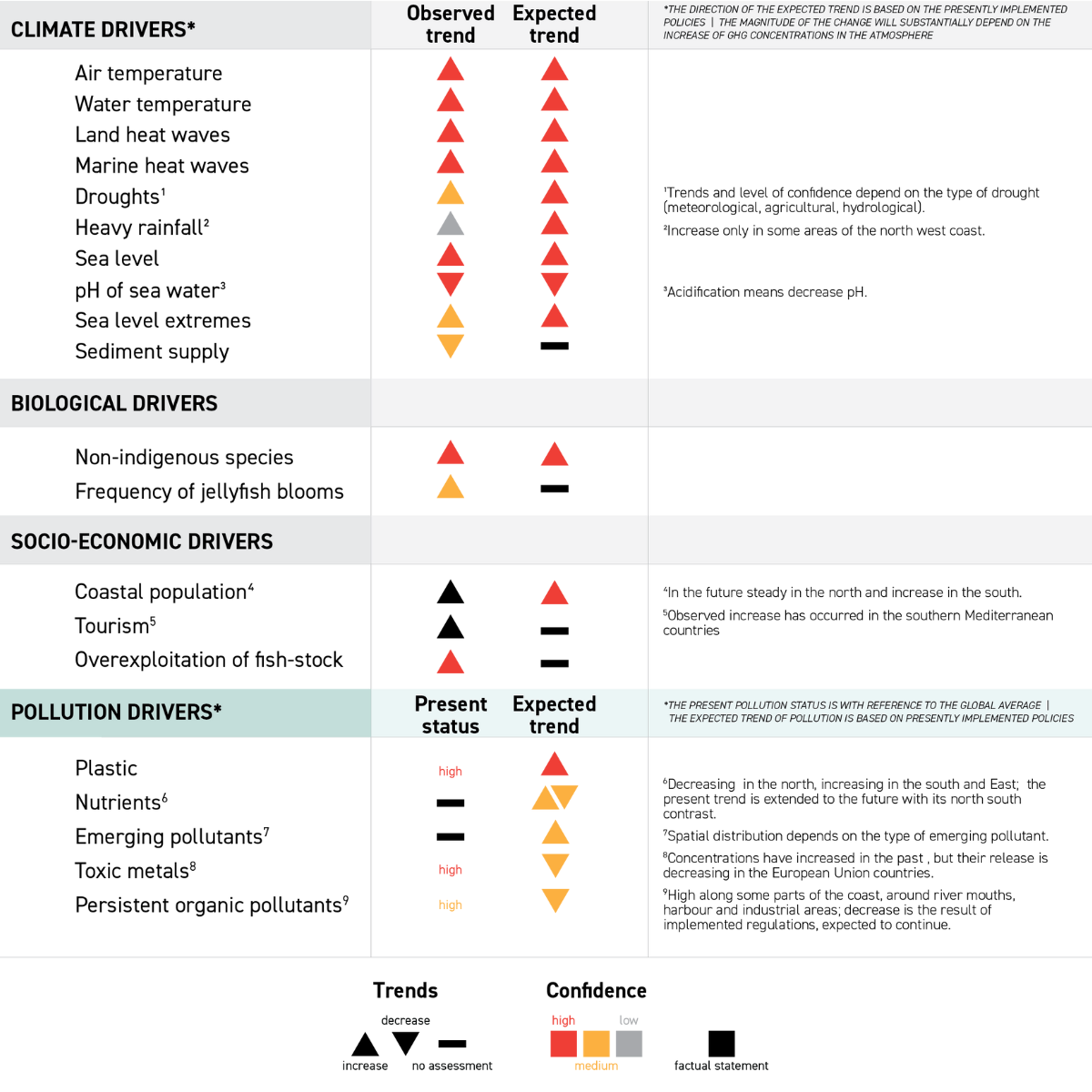
Figure SPM3 | Drivers of change and their expected evolution in the Mediterranean coastal zone
D. Observed impacts and future risks
D.1 In general, the Mediterranean coastline is presently retreating, with large spatial variability and it will increase under the effect of climate change with consequences for ecosystems and the protection efficiency of present structures (high confidence). {3.2.2}
D.1.1 The most dramatic erosion is observed in river mouth areas, on coastal stretches around harbours and other coastal infrastructure as a result of decreased sediment supply and alteration of sediment fluxes caused by coastal structures (very high confidence). {3.2.2}
D.1.2 In the absence of adequate adaptation and protection measures, beaches will continuously erode during the coming decades, increasing risks of storm-induced damages and reducing the extension of areas for sun-and-beach tourism (high confidence). {3.2.2}
D.1.3 Coastal erosion will increase under the effect of climate change, as mean sea level rise will enhance erosion in combination with storms, aggravating a generalised shoreline retreat. In the future the projected median value of shoreline retreat for the Mediterranean with respect to 2010 is 17.5 [8.8 to 27.7] m and 23 [11.1 to 36.3] m by 2050 under the intermediate and very high greenhouse gas emissions scenarios, respectively, increasing to 40 [20.1 to 65.1] m and 65 [31.3 to 115.0] m respectively by 2100 (medium confidence). {3.2.2}
D.1.4 Coastal erosion will increase flooding and reduce the degree of protection provided by existing infrastructure along the coast, thereby increasing risk of storm-induced damages (high confidence). {3.2.2}
D.1.5 Coastal erosion will also lead to a loss of ecosystem services as coastal zone habitats will be affected, degraded and, eventually, disappear due to coastal squeeze (medium confidence). {3.2.2}
D.2 Regional sea level rise will increase the risk of storm-related floods and also result in the permanent inundation of certain areas along the Mediterranean coasts. Climate change and growing urbanisation will further increase the risk of flash floods in some coastal areas (medium confidence). Risks caused by meteorological and seismic tsunamis will continue to be present (high confidence). (Figure SPM4) {3.2.3, 3.2.4}
D.2.1 In the Mediterranean, waterfronts, seaward parts of coastal settlements and low-lying areas are exposed to flood risk caused by waves during storms, which, in the absence of efficient adaptation/protection measures, will generally increase in the future because of mean sea level rise (high confidence). Future mean sea level rise will lead to an increased frequency and intensity of coastal floods (high confidence). {3.2.3}
D.2.2 Mean sea level rise will cause gradual and permanent inundation of low-lying unprotected areas in deltas and coastal plains, being locally often aggravated by subsidence, putting at risk natural and cultural values, and important agricultural activities (high confidence). {3.2.3}
D.2.3 Risks posed by flash floods are high in several coastal stretches of the Mediterranean because of exposed and vulnerable urban settlements, densely populated areas, local weather regimes, and topographic conditions. In the future, in the absence of efficient adaptation, flash flood risks are expected to increase in relation to the increase in the frequency of heavy rainfall events and population density in flood prone coastal areas (including Türkiye, Greece, Italy, France and Spain) (medium confidence). {3.2.3}
D.2.4 The Mediterranean coast is among the areas with the highest probability of compound flooding in comparison with European coasts due to the combined occurrence of heavy rainfall and high-water levels. The expected evolution of these events under climate change will be affected by the increase of both hazards, although with a large spatial variability in their occurrence and no clear trend regarding their intensity and frequency (medium confidence). {3.2.3}
D.2.5 The occurrence of meteotsunamis (tsunamis caused by meteorological events) is relatively frequent along some stretches of the Mediterranean coast (eastern Adriatic, Balearic Islands, strait of Sicily, Maltese Islands) with specific hotspots in some bays and inlets where resonance is favoured. They pose significant risks for Mediterranean coastal zones: Due to the small tidal ranges in the Mediterranean, coastal infrastructure is generally not adapted to avoid meteotsunami damages, and flooding is potentially more severe in the Mediterranean in comparison to other macro-tidal coasts of the world. {3.2.4}
D.2.6 Tsunamis produced by seismic events have caused severe damages and loss of lives in the past. Due to the high seismicity of the Mediterranean basin, the short travel times of tsunami waves to the coast from source areas and the concentration of population and assets along the coastal zone, tsunamis are a significant threat for the Mediterranean coastal zones despite their low frequency, with the eastern basin being the most affected. {3.2.4}
D.2.7 In the absence of effective adaptation policies in the Mediterranean region, up to 20 million people could be affected by permanent displacement due to sea-level rise by 2100. This exposure is about three times higher in the southern and eastern countries than in the northern countries (low confidence). {3.4.2}
D.3 Risks of water scarcity in the coastal areas of the Mediterranean are caused by the overall drying trend affecting the region, salinisation of coastal aquifers, increasing demand associated with population growth, irrigation, touristic use, industry and the energy sector. Risks of water scarcity are expected to increase in the future (high confidence) (Figure SPM4) {3.2.5}
D.3.1 Seawater intrusion in coastal aquifers affects a considerable part of the Mediterranean coast. In the future, salinisation of aquifers could further increase in the coastal areas affected by relative sea level rise (high confidence). {3.2.5}
D.3.2 Tourism and irrigated agriculture produce water demand peaks during summer. Increase in irrigation demand (driven by climate change and agricultural practices), the increase in population, particularly in the coastal areas of eastern and southern Mediterranean countries, and summer tourism are expected to lead to growing water demand in the future (high confidence). In the future, reduced precipitation and increased evapotranspiration will lead to a decline of runoff in the Mediterranean region and consequently affect the supply of fresh water to coastal areas (high confidence). {3.2.5}
D.3.3 Future degradation and reduction of the availability of conventional freshwater resources for the different uses is expected, especially in the southern and eastern Mediterranean (high confidence). {3.2.5}
D.4 Mediterranean coastal wetlands have significantly declined since the beginning of the 20th century. Coastal ecosystems and their services are at risk of further deterioration in the future. Risks can be further increased by changes in sediment supply, and industrial and urban development (high confidence). (Figure SPM4)
D.4.1 Mediterranean coastal wetlands have experienced a substantial decline, losing approximately 50 % of their area during the 20th century, due to a combination of erosion, extreme events, salt-water intrusion, and mainly human-induced pressures (such as expansion of irrigated agriculture), and urban, industrial and infrastructure development. They will be significantly affected by future changes in precipitation (high confidence), although with a high spatial variability. Sea level rise and coastal erosion will lead to further losses of coastal wetlands (high confidence), especially in areas where existing rigid inland boundaries limit the potential horizontal migration of wetlands. {3.5}
D.4.2 Degradation, regression and biodiversity loss, and, eventually, disappearance of ecosystem habitats will lead to an overall decline in ecosystem services relative to current conditions (high confidence). For the northern Mediterranean coast, the decline in services could reach around 6% of the present value by 2100 under the very high greenhouse gas emissions scenario, but with high spatial variability and the largest decline occurring in the north-eastern Mediterranean areas (medium confidence). A lack of studies prevents assessment for the rest of the Mediterranean coastline. {3.5.2}
D.4.3 The decrease in sediment supply, coupled with further industrial, urban and tourism development, can enhance the vulnerability of coastal sandy beaches, wetlands, and saltmarshes to sea level rise. {3.5.2}
D.5 In the Mediterranean Sea mass mortalities in coastal waters have been recently observed, they have been partially attributed to marine heat waves and are expected to increase in the future (high confidence). {3.2.7}
D.5.1 Mass mortality events in the Mediterranean Sea have been observed in recent decades, affecting corals, sponges, molluscs, bryozoans and echinoderms, and they have been attributed to marine heat waves and pathogen infections. Many Mediterranean coastal species are reaching their tolerance limits due to ocean warming and repeated marine heat waves (high confidence). {3.2.7}
D.5.2 The frequency and intensity of mass mortality events will likely increase in the future in parallel with rising marine heat waves (high confidence). {3.2.7}
D.5.3 Mortality risks are increased by the synergistic effects of warming and pollution (medium confidence). {3.2.6}
D.6 Alteration of species distribution and population have been observed, such as the presence of non-indigenous species and jellyfish blooms. {3.2.7}
D.6.1 Non-indigenous species affect indigenous species through predation, competition for resources and ecological niches, food web shifts and as vectors of pathogens or parasites. Non-indigenous species are producing a variety of ecological and socio-economic impacts on the Mediterranean, with examples of negative impacts on native biodiversity and coastal ecosystem services, mainly food provision (high confidence). {3.2.7}
D.6.2 Recent studies suggest an increase in the frequency of jellyfish blooms in the Mediterranean Sea, which has been linked to eutrophication and other human induced stressors, including anthropogenic warming (medium confidence) {2.3.3}
D.7 In the Mediterranean coastal region, climate change is expected to pose serious risks to important economic sectors such as summer beach tourism, agriculture, aquaculture and fisheries (high confidence). (Figure SPM4) {3.3}
D.7.1 Hot temperatures and heat waves are expected to reduce the traditional attractiveness of the Mediterranean beaches in the summer, while increasing suitability of spring and autumn seasons for beach tourism (medium confidence). The narrowing and eventual disappearance of beaches poses high risks for the sun-and-beach tourism sector, especially in urbanised areas where the coastal zone is limited by physical barriers, such as numerous coastal stretches in Cyprus, France, Greece, Italy, Malta and Spain, among other countries (high confidence). {3.3.1}
D.7.2 In the coastal areas of the Mediterranean, risks for agricultural productivity are posed by the overall loss of the quality and availability of water resources and the loss of agricultural land, caused by erosion and permanent submersion. In absence of adequate adaptation, agricultural land located in low-lying coastal areas, such as the plains of the Nile, Ebro and Po deltas, will be affected by the impacts of relative sea level rise (high confidence). {3.3.2}
D.7.3 Climate change is affecting the range and quantity of species available for commercial exploitation (medium confidence) and favouring the emergence of non-indigenous species (medium confidence). Mediterranean fisheries are overexploited and the majority of stocks are declining (high confidence). {3.3.3}
D.8 Sea level rise is expected to put Mediterranean coastal structures, such as airports, transport networks, ports, and cultural heritage sites at risk (high confidence). {3.3.5, 3.4.1}
D.8.1 Three out of the world’s 20 airports most at risk of coastal flooding due to sea level rise are located in the Mediterranean. In several Mediterranean countries, roads and railways are located close to the shoreline and exposed to the risk of flooding and erosion. Multi-hazard conditions affecting Mediterranean ports are projected to significantly worsen due to climate change under a very high emission scenario. The absence of adequate adaptation will increase risks for operating Mediterranean ports, particularly in the southern Mediterranean. The extent of this increase will vary depending on local conditions, with port configuration being a crucial factor (medium confidence). {3.3.5}
D.8.2 Sea level rise is expected to reduce the effectiveness of protection provided to the coast by parallel breakwaters, due to increased overtopping. The extent of this impact will largely depend on the height of the structures (high confidence). Significant sea level rise will make the design and planned operativity of the current Venice defence systems inadequate (medium confidence). {3.3.5}
D.8.3 The large majority of Mediterranean UNESCO cultural World Heritage Sites in low elevation coastal zones are currently at risk of erosion and coastal flooding (high confidence). Coastal built heritage is likely to also be affected by slow cumulative deterioration processes, with an increase in the risk of decohesion due to salt crystallisation and mechanical stress (very high confidence). {3.4.1}
D.9 Diverse pollutants affect the coastal waters of the Mediterranean Sea with negative impacts on ecological systems, human health and economic sectors (aquaculture, fishing, and coastal tourism). The risks associated with coastal pollution are expected to increase as anthropogenic pressures in coastal zones continue to grow, exacerbated by the compounding effects of climate change, leading to cumulative and synergistic impacts (medium confidence). (Figure SPM4) {3.2.6, 3.2.7}
D.9.1 High nutrient fluxes from land sources cause eutrophication with adverse consequences, such as hypoxia or anoxia, episodes of massive mucilage formation and harmful algal blooms. Mucilage has been reported, particularly in highly productive and shallow water coastal areas of the Mediterranean. It reinforces hypoxic and anoxic conditions, negatively affecting benthic organisms and damaging tourism and fisheries. {3.2.6, 3.2.7}
D.9.2 Metals are accumulating in estuaries, wetlands, deltas, prodeltas and, more generally, in coastal and seafloor sediments with some having negative impacts on organisms (such as immunosuppression, impaired reproduction and development) even at minute concentration. They also accumulate in marine organisms throughout food webs (the bioaccumulation of mercury is a representative example). {3.2.6}
D.9.3 Pharmaceutical residuals and other emerging pollutants reach coastal waters through rivers and domestic effluents, where conventional processes are unable to treat them. These emerging pollutants present a risk of acute or chronic toxicity to aquatic organisms (medium confidence). {3.2.6}
D.9.4 High concentrations of plastics are a major risk for marine biodiversity. Coastal areas are generally hotspots for plastic ingestion and coastal species are at higher risk than open-sea species (medium confidence). Risks to human health are due to the ingestion and accumulation by commercially exploited seafood, and spread through the trophic chain (medium confidence). {3.2.6}
D.9.5 Complex interactions between climate change impacts and pollutants in the coastal environment will become more frequent due to multiple stressors from both natural and anthropogenic sources (medium confidence). {3.2.6}
D.9.6 The occurrence of natural disasters and environmental degradation linked to pollution has multiple direct and indirect impacts on the health and well-being of coastal populations along the Mediterranean Basin. In the absence of effective adaptation, risks are expected to increase in the near future as climate change hazards and coastal populations are expected to increase (high confidence). {3.4.2}
E. Adaptation measures and solutions
E.1 Reducing risks posed by climate hazards has primarily included protection against coastal flooding, prevention of coastal erosion and conservation measures for coastal ecosystems. Both protection against coastal flooding and management of coastal erosion generally fail to properly consider future sea level rise, with risks of limited future effectivenessefficiency (high confidence). The effectiveness of conservation measures for coastal ecosystems strongly depends on the success of climate change mitigation and an increasing number of hard limits will be reached for every increment of global warming (high confidence). (Figure SPM4)
E.1.1 Protection against coastal flooding, except for a few examples of relocation and nature-based solutions, typically relies on relatively high-cost engineering solutions, with negative effects on coastal landscape, biodiversity and ecosystems (high confidence). The lack of consideration of sea level rise in coastal flood-risk management is widespread and comes with the risk that during the 21st century, defence systems will reach soft limits, lock-ins and maladaptation (high confidence). {4.2.1}
E.1.2 Prevention of coastal erosion by engineering protection and artificial nourishment of beaches is becoming less efficient due to sediment scarcity (medium confidence). Nature-based solutions are increasingly discussed. They have economic and environmental advantages, but trade-offs with the use of beaches, and coastal resources limit the scale of their implementation (high confidence). Landward relocation with appropriate planning could represent a sustainable solution in some areas, especially when other adaptation measures are not viable. Along the European Mediterranean coastline, relocation is limited by the lack of space in low-lying coastal areas and by low social and current economic feasibility, but it might become economically viable in the long term (medium confidence). {4.2.2}
E.1.3 Current management of coastal erosion generally overlooks the risks posed by sea level rise (high confidence). Transparent communication and governance are essential for avoiding short-term interventions and maladaptation in the future (medium confidence). {4.2.2}
E.1.4 Autonomous adaptation of coastal ecosystems requires adequate conservation measures, such as habitat protection, limitation of human pressures, reduction of pollution, ensuring sufficient accommodation space and area-based conservation measures, which in the Mediterranean are too limited in scale and ambition to curb coastal ecosystem losses (high confidence). Active restoration remains too limited to support the recovery of habitats at relevant ecological scales, while coastal protection measures reduce and fragment habitats (high confidence). {4.2.3}
E.1.5 The efficiency of conservation measures strongly depends on the success of climate change mitigation, that is limiting warming climate change below 1.5°C with no or small overshoot (medium confidence). Adaptation limits of coastal terrestrial, freshwater and brackish water ecosystems will be reached above 3°C of global warming in the north-eastern Mediterranean and possibly earlier in the eastern and southern Mediterranean (high confidence). {4.2.3, 4.2.4}
E.1.6 Reducing the risk of possible conflicts and side-effects of some adaptation actions on other related sectors can be achieved through cross-sectoral adaptation strategies. Such strategies, if included in a regional “Mediterranean” framework, would enable cooperation and more effective cross-border measures to be undertaken. {4.2.3}
E.2 Mediterranean coastal waters are heavily influenced by pollution originating from numerous mainly land-based human activities such as industry, agriculture, urbanisation, and tourism. Actions to control pollution at its sources are generally more efficient than those treating it at endpoints (medium confidence). Actions to tackle pollution at a Mediterranean scale have not been implemented yet, and technical and decision-making challenges remain to be solved. (Figure SPM4) {4.3}
E.2.1 Management of pollution both at the sources and at the endpoints requires continued long-term monitoring, using an appropriate set of indicators and adaptive recovery management plans (high confidence). Actions aimed at the sources are more efficient, particularly in the case of point sources, as they are usually simpler to be implemented, long-lasting, easier to monitor, and cheaper, while they are more problematic in the case of dispersed sources and at endpoints (medium confidence). {4.3}
E.2.2 Strategies to reduce coastal pollution include use of municipal solid waste for the waste-to-energy industry, recycling and re-use of wastewater, sustainable farming practices and more efficient treatment of polluted water from farming activities and eco-remediation. {4.3.1, 4.3.2}
E.2.3 There is currently no consistent strategy approach to reduce plastic litter pollution at Mediterranean scale, as the gap between politics, science and society still complicates the joint design development and implementation of effective mitigation measures. The effectiveness of solutions is further still limited by knowledge gaps, technical difficulties and economic costs (medium confidence). {4.3.4}
E.2.4 The implementation of pollution management strategies differs among Mediterranean countries. In order to ensure effective decision-making, coordination among parties, improved spatial consistency of information on litter distribution, and awareness-raising measures are fundamental. {4.3.5}
E.2.5 Waste prevention through law-enforcement, appropriate waste management and monitoring the effectiveness of implemented actions (such as those included in the European Marine Strategy Framework Directive) are important components to achieving Good Environmental Status {4.3.4}.
E.3 Although the presence of non-indigenous species is observed throughout the Mediterranean region, solutions have been rarely attempted, with few successful examples. Management of non-indigenous species are based on actions at regional levels: eradication initiatives; efforts for their commercial exploitation; protection of indigenous species by providing suitable habitat, protected areas, and ecological connectivity. {4.4}
E.4 Adaptation needs to water shortages vary significantly across sub-regions, depending on the hydrogeological and coastal water management context. Adaptation to reduced water availability is taking place in Mediterranean coastal areas (high confidence). These adaptation options consist in increasing water supply, improving water quality, supporting measures and governance, and to a lesser extent reducing water demand (Figure SPM4) {4.2.4}.
E.4.1 Observed adaptation to reduced water availability is often based on increasing water supply based on diversified strategies (water diversion and transfers, diversification of resources, surface reservoirs, desalination), which, though effective, pose social, environmental, and economic challenges, and can reach hard limits (high confidence). {4.2.4}
E.4.2 Water demand management measures, although an important component to limiting future risks of water scarcity, are not widely used (high confidence). Sustainable water demand can be achieved by improving irrigation practices, changing agricultural practices, improving urban water management, through economic and financial incentives, and regulating distribution (high confidence). {4.2.4}
E.4.3 Nature-based solutions, such as favouring saltmarsh accretion to reduce surface saltwater inflow into aquifers and estuaries have limitations in terms of feasibility and efficiency for high rates of sea level rise (high confidence). {4.2.4}
E.4.4 A transformation of the water-food-energy nexus, while taking into account the ecosystem, can bring substantial co-benefits to the reduction of water shortage risks, such as improved human health, aquaculture easing and healthier terrestrial and freshwater ecosystems (high confidence). {4.3}
E.5 The engagement of scientists with policymakers, stakeholders, and citizens is a key factor to removing barriers (including lack of understanding and trust) and can be particularly beneficial during the planning process. Turning stakeholders into partners significantly increases the potential of successfully implementing solutions and adaptation measures (high confidence). {4.7}
E.5.1 Coastal adaptation management and planning processes provide unique opportunities for the establishment of permanent frameworks for science-policy-community interaction. Such frameworks require sufficient resources, are based on transparency and are the key for building partnerships and trust. Plans that are co-created by science-policy-community groups strongly increase their chances for successful implementation (high confidence). {4.7.3}
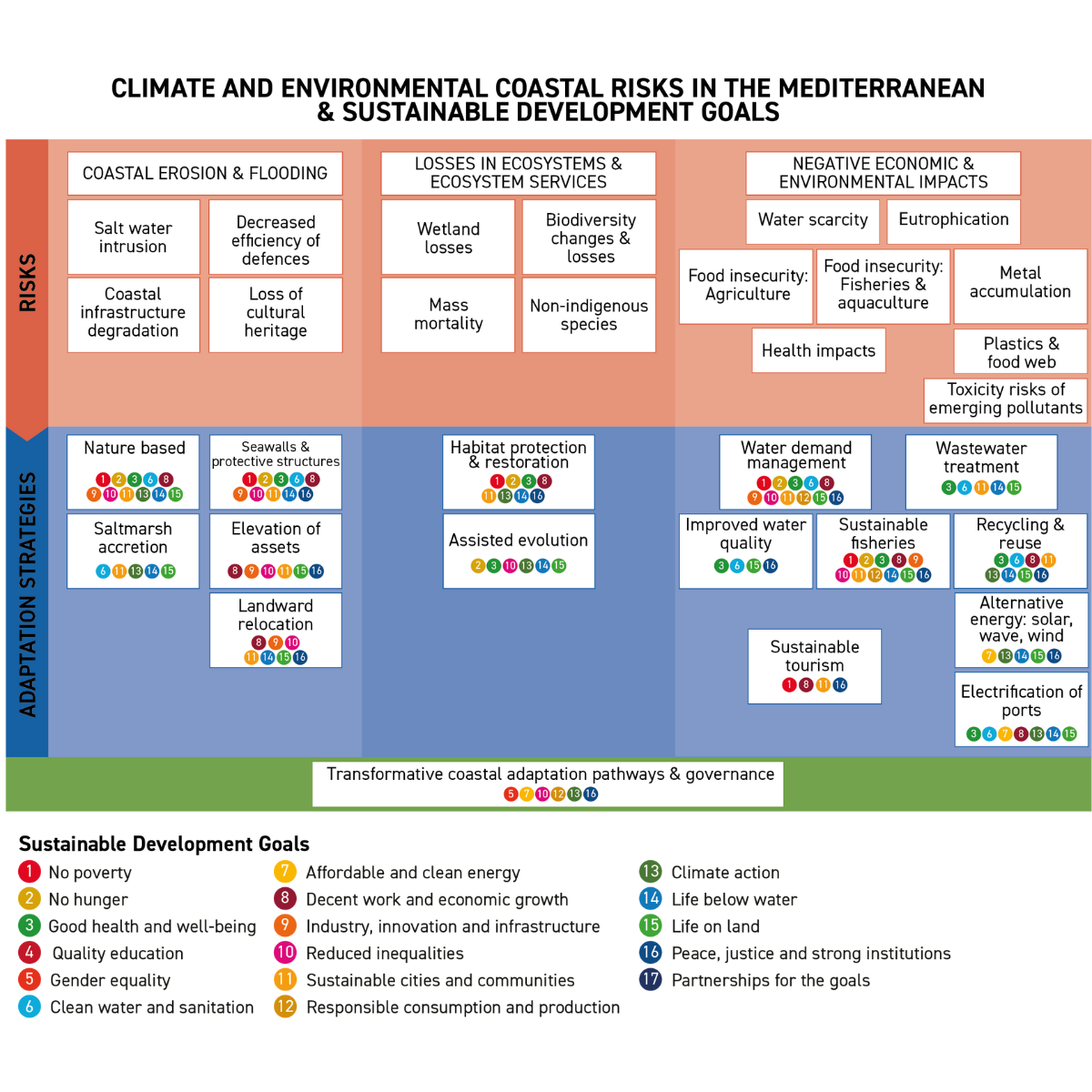
Figure SPM4 | Risks, adaptation and solution in the Mediterranean coastal zone and their links to the Sustainable Development Goals (SDGs).
F. Recent developments and sustainable development pathways
F.1 Current actions towards solutions to environmental problems, adaptation to climate change and its mitigation are insufficient to attain the Sustainable Development Goals (SDGs) ensuring the well-being of people and the sustainability of resources in the Mediterranean coastal zone (medium confidence). {5.2, 5.3}
F.1.1 Climate change, in combination with other drivers such as urbanisation, rural exodus, and population growth, are a threat to the vital services provided by Mediterranean marine and coastal ecosystems (high confidence). (Figure SPM4) {5.4.5}
F.1.2 Further research is needed to establish the risks posed by the implementation of renewable energy projects (wind, solar and wave energies, hybrid systems) to the unique biodiversity of Mediterranean coastal ecosystems (medium confidence). {5.3}
F.1.3 The most vulnerable people in society – such as the elderly, migrants, refugees, internally displaced individuals, women, children and low-income earners – who are exposed to climate hazards, such as heat waves and flooding, among others, are in many cases not adequately engaged in the policy-making processes nor adequately considered in policy measures, to ensure efficient and just transition to changing environment and climate (medium confidence). {5.4}
F.1.4 Crucial socioeconomic sectors, such as tourism, ports and maritime transport, construction and real estate, contribute to economic development and employment, but are largely based on extractive models of development, insufficiently embracing circularity and sustainable development practices (medium confidence). {5.3}
F.1.5 The current share of carbon emissions of the Mediterranean countries amounts to no more than 6 percent of global emissions, with northern Mediterranean countries contributing the largest proportion. While greenhouse gas emissions in northern Mediterranean countries have been systematically decreasing since 2005, they have been continuously increasing in southern and eastern Mediterranean countries since the 1960s, mainly driven by economic and population growth and do not show a promising path in their reduction given the expected increase in energy demand in the next few decades (high confidence). {5.2.1}
F.1.6 Among renewable energy sources in the Mediterranean coastal zone, offshore wind energy is a feasible viable option while wave and thermal gradient energies are still in the early stages (medium confidence). Despite some progress in promoting the transition from fossil fuels to renewable and clean energy sources and efforts to support conservation and restoration of blue carbon pools (such as coastal ecosystems), sustainable development pathways are not progressing sufficiently to achieve net zero targets by the mid-21st century (high confidence). {5.3}
F.1.7 Low carbon energy pathways in coastal economies are essential for sustainable local and regional economic growth and stability (medium confidence). In the quest for decarbonisation, alternative fuels and energy sources such as biofuels, synthetic fuels, hydrogen, and batteries are emerging in the Mediterranean. Transition to more economically, socially and environmentally sustainable maritime transport would result in relatively lower carbon emissions per tonne transported compared to land and air transport (low confidence) {5.3.1}
F.2 Without transformative actions across all sectors, systems, and scales climate change risks will be exacerbated and the UN Sustainable Development Goals will not be met (high confidence). A mix of legal, policy and economic instruments, and behavioural nudges, are available for local, national, and regional authorities to promote effective climate resilient sustainable development pathways in the Mediterranean coastal zone. Properly identifying vulnerabilities related to human activities and climate change impacts, assessing opportunities to reduce risks to the affected communities and ecosystems, and adopting actions consistent with the Sustainable Development Goals are fundamental for pursuing these goals (high confidence). (Figure SPM4) {5.3, 5.4}
F.2.1 Carbon neutrality by 2050 can only be reached by ensuring more political and economic stability, and implementing circular and sustainable development models, especially in southern and eastern Mediterranean countries, in order to decouple energy consumption from economic growth (high confidence). {5.2.2}
F.2.2 There is a consistent potential for climate change mitigation and adaptation through effective conservation and restoration of blue carbon ecosystems including seagrass meadows, coastal wetlands, salt marshes and coastal terrestrial ecosystems (including coastal dunes). The carbon sequestration capacity of coastal wetlands is about 10 times that of terrestrial ecosystems, but they are not sufficiently protected (high confidence). {5.2.2}
F.2.3 An effective implementation of the sustainable blue economy is a powerful way to protect and transform Mediterranean marine and coastal areas, fostering resources for local, inclusive, sustainable and resilient development (high confidence). Ensuring continuous monitoring and assessment of coastal ecosystems and their valuable services can support the adoption of dynamic adaptive strategies (medium confidence). {5.2.2}
F.2.4 Coastal tourism is a strong economic driver and as such has a key role in fostering sustainable development pathways, especially by shifting from generally wasteful and overconsumption practices to more circular and sustainable ones (medium confidence). Sustainable tourism, which promotes local communities and conserves natural resources, is endorsed by international organisations and programs. Ecotourism models can use alternative policy tools including green taxes and eco-labelling schemes (high confidence). Additionally, the negative impacts of tourist cruises on air quality can be reduced by electrification of ports and controlling the emission of pollutants (medium confidence). {5.3.1, 5.3.2}
F.2.5 Actions towards reducing the overexploitation of fish stocks and the resulting negative impacts, particularly on small-scale fishers, include their meaningful participation in the co-management of the sector, the implementation of best practices to maximise the value of catches and the establishment of vertically-integrated distribution channels especially at local level (high confidence). {5.3.1}
F.3 Social inequalities, access to basic service, and gender-based inequalities are issues of concern in the Mediterranean region and in its high urbanised coastal zone as they act as a barrier to the implementation of sustainable development pathways (high confidence) {5.4}
F.3.1 Existing social inequalities across the Mediterranean Basin act as a further barrier to climate change adaptation and sustainable development pathways. A careful analysis of distributional effects of policies, adaptation actions and development programmes is fundamental to avoiding the risk of negatively impacting low-income earners (high confidence). {5.4.1}
F.3.2 Social infrastructure has a positive impact on social cohesion, by ensuring equal access to basic services (such as healthcare and education) across cities and regions. However existing inequalities within and among Mediterranean countries can undermine social cohesion (high confidence). {5.4.2}
F.3.3 In the Mediterranean countries where gender-based inequality is high, developing transformative coastal adaptation pathways by empowering women’s participation in decision-making and support programmes, contributes to the achievement of SDG 5 – Gender equality (high confidence). {5.4.4}
How to cite the report
Contributors
Editors

Salpie
Djoundourian
Lebanese American University / Lebanon
hide

Piero
Lionello
University of Salento / Italy
hide

María Carmen
Llasat
Department of Applied Physics, University of Barcelona (UB) / Spain
hide

Wolfgang
Cramer
IMBE, CNRS / France
hide

Fatima
Driouech
University Mohammed VI Polytechnic (UM6P) / Morocco
hide

Joël
Guiot
CEREGE, CNRS / France
hide

Julie
Gattacceca
MedECC Secretariat / France
hide
Association AIR Climat / France
hide
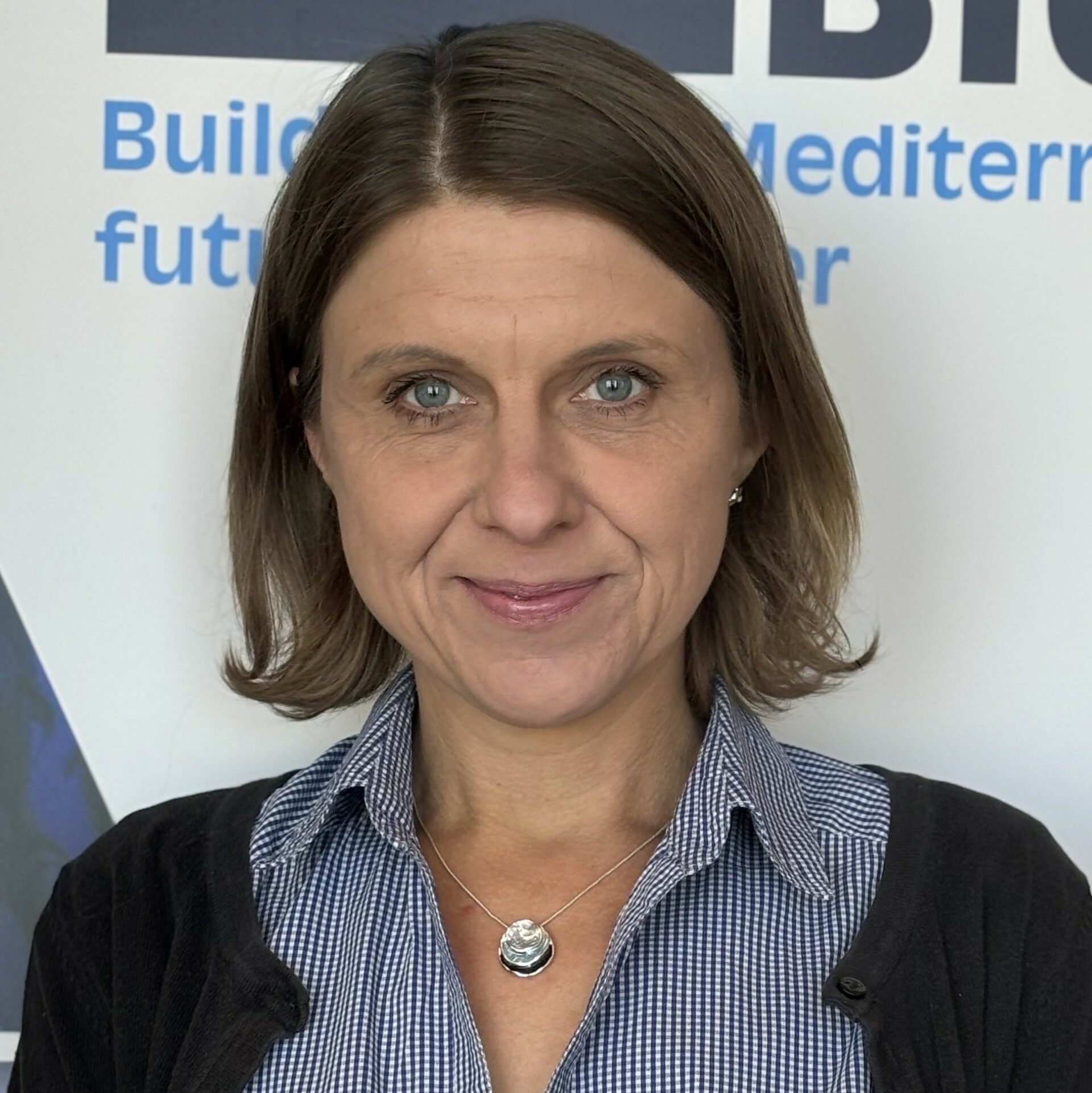
Katarzyna
Marini
MedECC Secretariat / France
hide
Plan Bleu / France
hide
Report Coordinators
Coordinating Lead Authors

Mohamed
Abdrabo
Alexandria University / Egypt
hide

Murat
Belivermiş
Istanbul University / Türkiye
hide

Zinet Selmin
Burak
Istanbul University / Türkiye
hide

Dario
Camuffo
National Research Council of Italy (CNR), Institute of Atmospheric Sciences and Climate / Italy
hide

Nathalie
Hilmi
Centre Scientifique de Monaco / Monaco
hide

José A.
Jiménez
Universitat Politècnica de Catalunya · BarcelonaTech / Spain
hide

Suzan
Kholeif
National Institute of Oceanography and Fisheries Egypt (NIOF) / Egypt
hide

Stefano
Moncada
University of Malta - Islands and Small States Institute / Malta
hide

Anna
Pirani
Euro-Mediterranean Centre on Climate Change (CMCC) / Italy
hide
Università Ca’ Foscari Venezia / Italy
hide

Agustín
Sánchez-Arcilla
Universitat Politecnica de Catalunya (UPC-BarcelonaTech) / Spain
hide

Athanasios (Nassos)
Vafeidis
University of Kiel / Germany/Greece
hide


